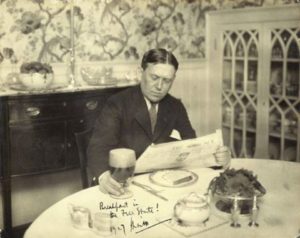
Jay posted this photo on Facebook this evening and I had to poach it. One of my favorite H.L.Mencken passages is this one from an essay about his your titled “The Baltimore of the Eighties“:
It was the opinion of my father, as I have recorded, that all the Baltimore beers were poisonous, but he nevertheless kept a supply of them in the house for visiting plumbers, tinners, cellar-inspectors, tax-assessors and so on, and for Class D social callers. I find by his bill file that he paid $1.20 for a case of twenty-four bottles. His own favorite malt liquor was Anheuser-Busch, but he also made occasional experiments with the other brands that were then beginning to find a national market: some of them to survive to this day, but the most perished under Prohibition. His same bill file shows that on December 27, 1883, he paid Courtney, Fairall and Company, then the favorite fancy grocers of Baltimore, $4 for a gallon of Monticello whiskey. It retails now for from $3 to $3.50 a quart. In those days it was always straight, for the old-time Baltimoreans regarded blends with great suspicion, though many of the widely-advertised brands of Maryland rye were of that character. They drank straight whiskey straight, disdaining both diluents and chases. I don’t recall ever seeing my father drink a high-ball; the thing must have existed in his day, for he lived on to 1899, but he probably regarded its use as unmanly and ignoble. Before every meal, including breakfast, he ducked into the cupboard in the dining-room and poured out a substantial hooker of rye, and when he emerged he was always sucking in a great whiff of air to cool off his tonsils. He regarded this appetizer as necessary to his well-being. He said that it was the best medicine he had ever found for toning up his stomach.
Not to mention this one:
…there are still oyster-roasts in Baltimore on Winter Sunday afternoons, and since the collapse of Prohibition they have been drawing pretty good houses. When the Elks give one they hire a militia armory, lay in a thousand kegs of beer, engage 200 waiters, and prepare for a mob. But the mob is not attracted by the oysters alone; it comes mainly to eat hot-dogs, barbecued beef and sauerkraut and to wash down these lowly victuals with the beer. The greatest crab cook of the days I remember was Tom McNulty, originally a whiskey drummer but in the end sheriff of Baltimore, and the most venerated oyster cook was a cop named Fred. Tom’s specialty was made by spearing a slice of bacon on a large fork, jamming a soft crab down on it, holding the two over a charcoal brazier until the bacon had melted over the crab, and then slapping both upon a slice of hot toast.
I probably read that passage about that crab and bacon toast sandwich as well as those thousand kegs of beer thirty years ago and it still makes my mouth water. My kind of pairing and breakfast in the free state, indeed.
